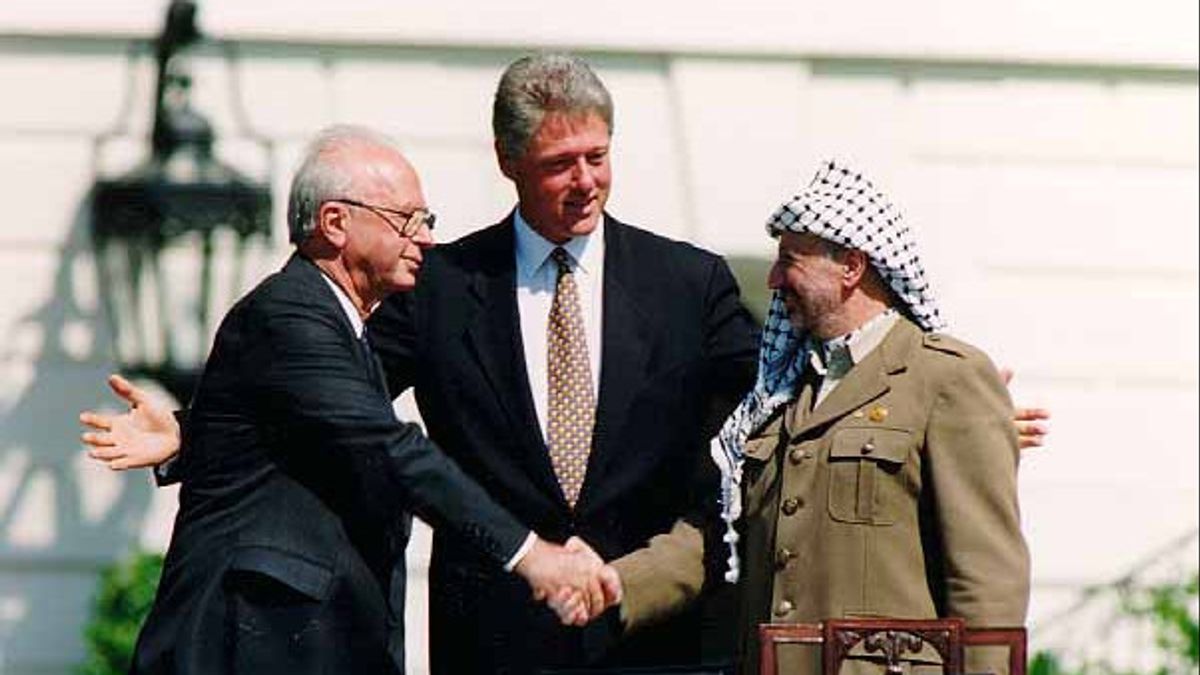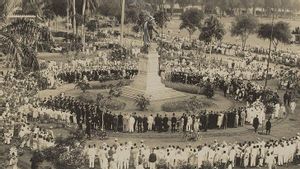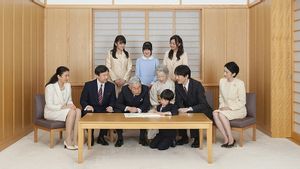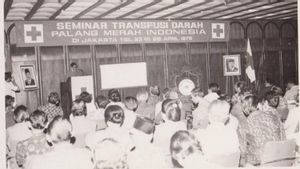JAKARTA - On September 13, 1993, Israeli Prime Minister Yitzhak Rabin and Chairman of the Palestine Liberation Organization (PLO) Yasser Arafat shook hands at a public event held at the White House, United States (US). The two signed an agreement called the Oslo I Accords, which provided efforts to provide a framework that would lead to a settlement of the Israeli-Palestinian conflict. The agreement is the first face-to-face agreement between Israel and the PLO.
Citing History, the Oslo I Treaty was the result of the Madrid Conference in 1991. The agreement was made in secret in Oslo, Norway, and organized by the Fafo Institute and was completed on August 20, 1993. The Oslo Treaty was then officially signed at a public event at the White House, Washington, DC, on September 13, 1993.
In addition to PLO Chairman Yasser Arafat and Israeli Prime Minister Yitzhak Rabin, US President Bill Clinton was also present at the signing. The documents themselves were signed by Mahmoud Abbas for the PLO, Israeli Foreign Minister Shimon Peres, US Secretary of State Warren Christopher, and Russian Foreign Minister Andrei Kozyrev.
The agreement also provides for the establishment of temporary Palestinian self-government, the Palestinian National Authority (PNA). The Palestinian Authority will be responsible for the administration of the territories under its control. The agreement also calls for the withdrawal of the Israel Defense Forces (IDF) from parts of the Gaza Strip and the West Bank.
At that time, the agreement would last for a five-year interim period during which a permanent agreement would be negotiated no later than May 1996. The remaining issues such as Jerusalem, Palestinian refugees, Israeli settlements, security, and borders would be part of the "permanent status negotiations" during the period.

In its Joint Acknowledgment Letter, the PLO also recognizes the State of Israel and pledges to reject violence. Israel also recognizes the PLO as the representative of the Palestinian people and as a partner in negotiations. Yasser Arafat was allowed to return to the Occupied Palestinian Territories. In 1995, the Oslo I Treaty was followed by the Oslo II Treaty. But unfortunately, neither of them promised an independent Palestinian state.
Fighting between Israelis and Palestinians began in the 1920s when both groups claimed territory previously controlled by Britain. The Jews in Israel who were new emigrants from Europe and Russia came to the Jewish homeland to establish a national state. The native Arabs, who at that time did not call themselves Palestinians, tried to stem Jewish immigration and establish a Palestinian state.
On May 14, 1948, Israel proclaimed itself a state. The proclamation was met with attacks by five Arab countries supporting the Palestinian Arabs. Israel fought Arab armies and captured substantial territory originally allocated to the Palestinians in the United Nations (UN) division of Palestine in 1947.
After two consecutive UN-brokered truces, Israel reached formal armistice agreements with Egypt, Lebanon, Jordan, and Syria in February 1949. These agreements put Israel in permanent control over the territories it had conquered during the conflict.
The departure of hundreds of thousands of Palestinian Arabs from Israel during the war left the country with a Jewish majority. Israel restricted the rights of the remaining Arabs. Most of the Palestinian Arabs leaving Israel retreated to the West Bank, then controlled by Transjordan (now Jordan), and others to the Gaza Strip, which is controlled by Egypt. Hundreds of thousands of exiled Palestinians have moved permanently to refugee camps.

By the early 1960s, the Palestinian Arab diaspora had formed a cohesive national identity. In 1964, the PLO was formed as a political umbrella organization for several Palestinian groups and was intended to represent the entire Palestinian people. The PLO calls for the destruction of Israel and the establishment of an independent Palestinian state.
In the 1967 Six-Day War, Israel controlled the West Bank, East Jerusalem, the Gaza Strip, the Sinai Peninsula, and the Golan Heights. Israel later annexed East Jerusalem and established a military government in the occupied territory. Israel offered to return some of the territories it seized in exchange for "Israeli security requirements." However, the Arab League chose not to enter into formal negotiations in the Khartoum Resolution of 1 September 1967.
Violence escalated in the 1980s, with Palestinians clashing with Jewish settlers in the occupied territories. In 1982, Israel invaded Lebanon to expel the PLO. In 1987, Palestinian residents of Gaza and the West Bank launched a series of violent demonstrations against Israeli authorities known as the intifada or "shaking."
Shortly thereafter, King Hussein of Jordan relinquished all administrative responsibility for the West Bank, thereby strengthening the PLO's influence there. As the intifada raged, Yasser Arafat proclaimed an independent Palestine in the West Bank and Gaza Strip on November 15, 1988. One month later, Yasser Arafat denounced terrorism, recognized the right of the State of Israel, and allowed the start of a “land for peace” with Israel.
After the Oslo I Treaty
The peace agreement, however, did not stop the efforts of extremists on both sides to sabotage the peace process by force. Israel completed the withdrawal of their troops from the Gaza Strip and Jericho in May 1994.
In July, Yasser Arafat entered Jericho amid much Palestinian excitement and established his government, the Palestinian Authority. In October 1994, Yasser Arafat, Yitzhak Rabin, and Shimon Peres were jointly awarded the Nobel Peace Prize for their efforts at reconciliation.
In September 1995, Rabin, Arafat, and Peres signed a peace agreement that provided for the expansion of Palestinian rule in the West Bank and democratic elections to determine the leadership of the Palestinian Authority. More than a month later, on November 4, 1995, Rabin was killed by Jewish extremists during a peace rally in Tel Aviv. Peres later became prime minister and promised to continue the peace process.
However, terrorist attacks by Palestinian extremists in early 1996 shook Israeli public opinion. When Benjamin Netanyahu was elected Prime Minister of Israel, Netanyahu insisted that Yasser Arafat fulfill his obligations to end terrorism by Palestinian extremists. But sporadic attacks have continued and the peace process has stalled.
*Read other information about TODAY'S HISTORY or read other interesting articles from Putri Ainur Islam.
Other TODAY'S HISTORY
SEE ALSO:
The English, Chinese, Japanese, Arabic, and French versions are automatically generated by the AI. So there may still be inaccuracies in translating, please always see Indonesian as our main language. (system supported by DigitalSiber.id)


















